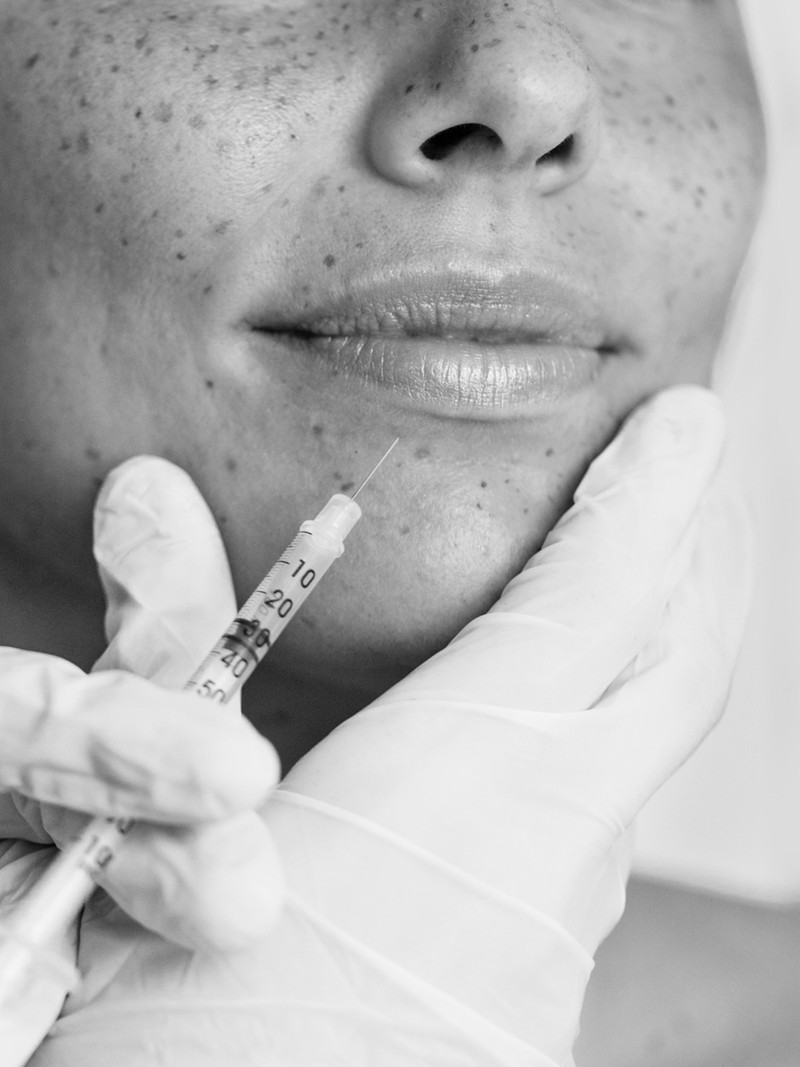A Comprehensive & Honest Guide To Lip Filler
What Lip Filler Is
“Lip fillers are cosmetic injectables that are used to enhance the shape, volume and overall appearance of the lips. The majority of lip fillers are composed of hyaluronic acid (HA) – a substance that’s naturally found in our bodies and contributes to our skin’s hydration and elasticity. When injected into the lips, these fillers provide a plumping effect, giving your mouth a fuller look.” – Dr David Jack, aesthetic doctor
“Lip filler normally has a bonding agent added to the chains of HA – this provides the gel with stiffness and longevity as human HA breaks down after a few days, whereas lip filler can last a year. The more bonding agent added to the HA, the stiffer or thicker it becomes and, in turn, the more lift and volume it can achieve. They can be injected to enhance the contour of your lips too, or to increase the vertical height – thereby increasing the amount of ‘pink lip’ visible.” – Dr Bibi Ghalaie, cosmetic physician
The Procedure Explained
“You should expect to have a detailed and thorough conversation with your injector, and you will also sign a formal consent form to ensure you’re happy to proceed. The injections will be carried out while you’re lying down. I use a topical numbing cream prior to treatment to assist with the procedure. The dermal filler I work with has the anaesthetic lidocaine mixed in with it to further ensure the patient doesn’t feel anything. I also use a cannula technique to reduce bruising and discomfort – ask your practitioner if they can do this if you’re concerned at all.” – Dr Nina Bal, cosmetic dental surgeon & advanced facial aesthetics practitioner
Your Options
“Most lip fillers now also contain lidocaine to help with the discomfort of the injections, but there are still a few on the market that don’t contain this. The most well-known brands to look out for are Teoxane, Juvederm and Restylane. I use Teoxane lip fillers as I believe they are the best on the market and produce the most natural-looking results.” – Bibi
“It’s also worth knowing there are different injection techniques and styles on offer. Always discuss this with your practitioner as you can achieve specific outcomes depending on your needs and preferences. That includes defining just the border, or adding volume centrally to the body of your lips. You can get very tailored results now, so always discuss your options in full.” – David
What To Consider & Ask
“If you’re considering lip fillers, do your research and always look at the qualifications of your injector. You need to make sure they have the experience and also the right quality of product to ensure you have the best care and results. A good expert will have narrowed down their range to use the products they know are safe, have good research behind them and deliver predictable results.” –Nina
“The filler should be HA and dissolvable – and thereby reversible. I recommend asking how much swelling to expect too.” – Bibi
A Note On Safety
“Lip fillers are generally considered safe when administered by a qualified professional – ideally a doctor with years of experience. However, there are risks and side effects to be aware of. This includes temporary swelling, bruising, redness and tenderness around the injection site. In rare cases, more serious complications like infection, an allergic reaction or vascular occlusion can occur. That’s why a reputable practitioner is crucial, as is a thorough consultation to assess your suitability.” – David
“It’s also worth noting the risk of filler migration – where it seeps outside of the lip line – distortion of shape and lumpiness. These are rare complications, but you would be able to have the filler dissolved immediately should this occur – providing your filler is HA-based. There is also the possibility of your immune system reacting to the filler. This is very rare but, again, worth noting as a possible risk.” – Bibi
How ‘Filler Reversal’ Works
“Lip filler can be reversed and dissolved with the agent hyalase, also known as hyaluronidase. This does come with its own risk, albeit rare, of anaphylaxis. It’s why I always recommend starting with a very small amount of dermal filler and then reviewing it. It’s a much easier way of managing expectations and assessing as you go, rather than doing a large injection in one go. Small amounts help maintain more natural results too – you need to respect the patient’s natural anatomy. Be conscious of anyone recommending too much.” – Nina
The Duration Of Results
“The duration of lip filler results varies from person to person – and it also comes down to the product used. Typically, you can expect the effects to last anywhere from six to 18 months. However, this isn’t set in stone, as individual metabolism, lifestyle factors and the amount of filler used can all influence your results.” – David

Who Is Eligible
“Most individuals can undergo lip filler, providing they are 18 or over. That said, it’s essential you disclose your medical history and any medications or supplements you are taking to your practitioner during your consultation process. Those undergoing chemotherapy or those who are immunosuppressed aren’t the best candidates for lip filler.” – David
Post-Treatment Aftercare
“I advise patients avoid alcohol and exercise for 48 hours post-filler. This helps with reducing bruising and swelling, although every injector’s guidelines are different, so you may get a different set of advice depending on who you see. Any swelling should slowly go down after 48-72 hours.” – Nina
“It’s also best to avoid touching or massaging the treated area afterwards. This will prevent your filler from shifting. Additionally, I always advise people to sleep with their head slightly raised – so use a few extra pillows. Try taking an antihistamine too as this can reduce excess swelling. Finally, avoid extreme temperatures – that goes for both hot and cold, as this will prevent any movement or slipping of filler.” – David
Where To Do Your Research
“First, you should be seeing a medic – so a doctor, dentist or nurse prescriber. This is because these clinicians are accountable to their governing bodies and, should something go wrong, they have a duty of care towards their patients. Once you have found a medic, check their qualifications on the General Medical Council (GMC) website for doctors, the general Dental Council or the Nursing Medical Council. Once you have chosen your practitioner, check which organisations they are registered with, such as the Joint Council For Aesthetic Practitioners (JCCP) or Save Face. It’s also important to check the online reviews. Finally, check the webpage of the company producing the fillers and see which medics are on their faculty. Generally, these medics are highly competent as they have to teach other doctors how to do these procedures. They will have been selected for their aesthetic knowledge and skillset.” – Bibi
“As well as scouting the correct websites, seek out personal recommendations. Friends, family or trusted healthcare professionals may have undergone similar treatments and will be able to advise you on the best practitioners out there. I also recommend looking for medics who are registered with the British College of Aesthetic Medicine or the Royal College of Surgeons – both high accolades that signify serious experience.” – David
Red Flags To Be Aware Of
“If a practitioner is offering extremely low prices or discounts that seem too good to be true, it may indicate a lack of expertise, or the use of inferior products. Additionally, be cautious if the practitioner doesn’t appear to have a full, proper set of qualifications, certifications or a well-established reputation. Don’t have it done in the back room of your local hairdresser.” – David
“A cheap, poor-quality filler to avoid is Revolax. If you’re not being asked to sign a thorough consent form, or if you’ve not had a detailed discussion regarding the risks and possible complications, this should serve as a red flag, too. A good clinician will tell you the complication rates and how they manage any that arise.” – Bibi
The Typical Costs
“There isn’t a set price as it depends on the experience and skill level of the injector. That said, you can expect it to be somewhere between £200 and £600. If the procedure costs less than this, I would question it.” – Bibi
Alternative Treatments
“Injecting Botox near the nose can help alter the appearance of a gummy smile and turn your lips upwards – we call this ‘lip eversion’. This is an option to consider if you want to avoid lip injections. There’s also lip blushing, a semi-permanent make-up that can give your lips a more hydrated look with better volume and fullness.” – Bibi
“You can also use Botox to relax the muscle around your lips for a softer, more diffused effect. Another option is ‘fat transfer’, where fat is harvested from one area of the body and injected into your lips. However, this requires surgery and is more invasive than fillers. Ultimately, the most suitable alternative depends on your goals and budget.” – David
Misconceptions Debunked
“One big misconception is that once lip fillers fade after 9-12 months, your lips will go back to looking shrunken and shrivelled. This isn’t the case at all if you’ve had them done professionally – in fact, it’s the opposite. Similarly, lots of people fear lip filler in case lips become excessively swollen or over-inflated. Again, if you’re seeing the right practitioner, they will work closely with you to understand the look you crave. A good practitioner will also tell you no if it’s not right.” – Bibi
“Skilled practitioners will achieve natural results by taking into account your features. They’ll then create balance and harmony with filler. This is primarily done by replacing lost volume rather than trying to create structure where it shouldn’t be – this is largely based on the aesthetic eye of the injector. With this in mind, the misconception of a ‘duck-like’ effect is outdated. Similarly, lots of people believe lip filler is permanent. As we’ve mentioned, this isn’t the case. You can dissolve them if needed. Lastly, some believe lip filler is only for creating a larger lip. In reality, they can be used to improve symmetry or address signs of ageing – there are many options now.” – David
Final Points Before You Book
“My biggest piece of advice is always to book an initial consultation, even if you don’t follow through with the filler. This will ensure you have a greater understanding on the treatment, as well as pre-and post-guidelines so you can make an informed decision. Ensuring you are adequately prepared is key and will mean you can ride the wave of recovery without panicking.” – Nina
“Lip fillers are not a one-size-fits-all solution. Each person’s lips and facial anatomy are unique so the treatment should be tailored to your needs and desires. Secondly, it’s important to have realistic expectations. Lip fillers can enhance the appearance of your lips, but they can’t transform them or change your entire face structure. Never rush the decision and take the time to find a trusted professional who understands your goals.” – Jack
“Please remember that less is more. It’s the one thing I wish everyone knew before they booked an appointment. A lesser approach is key to achieving natural-looking results. Lip volume should be increased very gradually. Not only will this help avoid distortion of the natural aesthetic, it will look softer and more believable.” – Bibi
Book a consultation with Bibi, Jack or Nina
Visit the General Medical Council, the Nursing & Midwifery Council & the JCCP for more information on practitioners & the procedure.
DISCLAIMER: We endeavour to always credit the correct original source of every image we use. If you think a credit may be incorrect, please contact us at info@sheerluxe.com.


